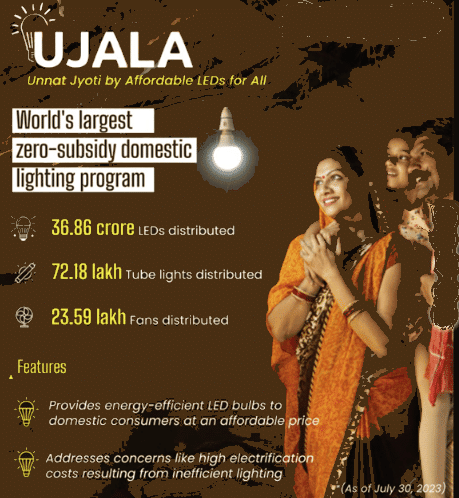UPSC Exam > UPSC Notes > PIB (Press Information Bureau) Summary > PIB Summary- 7th January, 2025
PIB Summary- 7th January, 2025 | PIB (Press Information Bureau) Summary - UPSC PDF Download
UJALA: 10 Years of Energy-Efficient Lighting
Context
Launched on 5th January 2015, UJALA aimed to transform household lighting in India by offering affordable energy-efficient LED bulbs, tube lights, and fans.

Introduction and Purpose of UJALA
- Initially known as the Domestic Efficient Lighting Programme (DELP), it later became UJALA, focusing on energy conservation, reducing electrification costs, and cutting carbon emissions.
- Over the last decade, more than 36 crore LED bulbs have been distributed, making India the world’s largest zero-subsidy lighting program.
Need for UJALA and Energy Efficiency
- Traditional lighting systems in India consumed excessive electricity, leading to high costs for consumers. LEDs, offering significant energy savings compared to CFLs and ICLs, were identified as a key solution.
- Prior to UJALA, LED bulbs were expensive, with retail prices ranging from Rs 450-500, making them inaccessible to many.
- Under UJALA, LED bulbs were made available at a subsidized rate of Rs 70 per bulb, drastically reducing the cost and increasing adoption across households.
- LED bulbs use significantly less electricity, consuming just 1 unit for 140 hours, compared to 2 units for CFLs and 9 units for ICLs, resulting in lower energy bills.
UJALA’s Achievements and Impact
- As of 6th January 2025, UJALA has distributed over 36.87 crore LED bulbs, contributing to major reductions in energy consumption and electricity bills for millions of households.
- The program has increased transparency and efficiency through e-procurement and competitive bidding, reducing costs and enhancing market competition.
- Beyond economic savings, the scheme has helped India reduce its carbon footprint, contributing to the nation’s goals of energy conservation and climate change mitigation.
Street Lighting National Programme (SLNP)
- Launched on the same day as UJALA, the Street Lighting National Programme (SLNP) aimed to replace conventional streetlights with LED lights, reducing energy consumption and operational costs for municipalities.
- EESL, the implementing agency, collaborated with urban and rural local bodies to execute the program, relieving municipalities from upfront investment costs through a unique business model.
- By January 2025, SLNP had installed over 1.34 crore LED streetlights, saving 9,001 million units of electricity annually, reducing peak demand by 1,500 MW, and cutting CO₂ emissions by 6.2 million tonnes per year.
Conclusion
- UJALA and SLNP together exemplify the impact of government initiatives in promoting energy efficiency, reducing energy costs, and mitigating environmental damage.
- These programs have transformed India’s lighting sector, helping households and municipalities save costs while fostering a sustainable, energy-efficient future.
Question for PIB Summary- 7th January, 2025Try yourself: What is the primary objective of UJALA and SLNP initiatives?View Solution
The document PIB Summary- 7th January, 2025 | PIB (Press Information Bureau) Summary - UPSC is a part of the UPSC Course PIB (Press Information Bureau) Summary.
All you need of UPSC at this link: UPSC
FAQs on PIB Summary- 7th January, 2025 - PIB (Press Information Bureau) Summary - UPSC
| 1. What is the UJALA scheme and its main objectives? |  |
Ans. The UJALA (Unnat Jyoti by Affordable LEDs for All) scheme is an initiative launched by the Government of India to promote energy-efficient lighting by distributing LED bulbs to households at a subsidized price. The main objectives of the UJALA scheme include reducing the overall energy consumption in the country, promoting the use of LED bulbs to minimize electricity bills for consumers, and contributing to environmental sustainability by lowering greenhouse gas emissions.
| 2. How has the UJALA scheme impacted energy consumption in India? |  |
Ans. The UJALA scheme has significantly reduced energy consumption across India by facilitating the widespread adoption of LED lighting. This transition has led to a decrease in electricity demand, which in turn reduces the strain on power grids. The scheme has also resulted in substantial savings for consumers on their electricity bills, with estimates suggesting a reduction of around 50% in lighting energy consumption for households that switched to LED bulbs.
| 3. What are the benefits of using LED bulbs promoted by the UJALA scheme? |  |
Ans. LED bulbs, as promoted by the UJALA scheme, offer several benefits including higher energy efficiency, longer lifespan, and reduced heat emissions compared to traditional incandescent bulbs. They consume up to 90% less electricity, last up to 25 times longer, and contribute to lower electricity bills for consumers. Additionally, their use helps in decreasing carbon emissions, thus aiding in climate change mitigation.
| 4. How can consumers participate in the UJALA scheme to get LED bulbs? |  |
Ans. Consumers can participate in the UJALA scheme by visiting designated distribution centers or authorized vendors in their locality. They need to provide a valid identity proof and may be required to pay a nominal fee for the LED bulbs. The scheme is designed to make LED bulbs accessible to a wide range of consumers, promoting energy efficiency at the grassroots level.
| 5. What achievements has the UJALA scheme made in its ten years of operation? |  |
Ans. In its ten years of operation, the UJALA scheme has achieved significant milestones, including the distribution of over 360 million LED bulbs across the country. This has led to estimated energy savings of around 47 billion kWh annually, translating to a reduction of approximately 38 million tonnes of CO2 emissions. The scheme has not only enhanced energy efficiency but has also created awareness about the importance of sustainable lighting solutions among the populace.
Related Searches
















